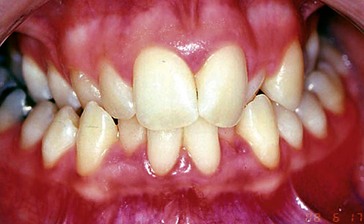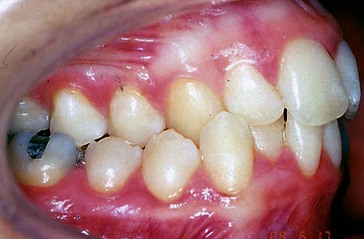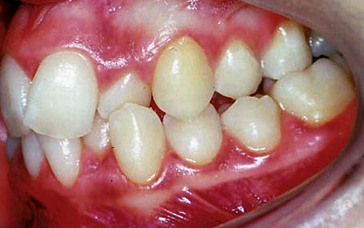15 Bilateral crossbite
Case 1
Summary
Jean has just turned 12. She presents with bilateral buccal crossbites (Fig. 15.1). What are the possible causes and how could it be managed?
History
Complaint
Jean does not like the ‘narrow’ appearance of her upper teeth, especially when she smiles.
Examination
Intraoral
 The appearance of the teeth on presentation is shown in Figures 15.1 and 15.2. Describe what you see
The appearance of the teeth on presentation is shown in Figures 15.1 and 15.2. Describe what you see
Moderate lower arch crowding;  appear slightly small (contact point displacements were 3 mm between
appear slightly small (contact point displacements were 3 mm between  and
and  ; also between
; also between  and
and  ); mild upper arch crowding
); mild upper arch crowding
 appear slightly small (contact point displacements were 3 mm between
appear slightly small (contact point displacements were 3 mm between  and
and  ; also between
; also between  and
and  ); mild upper arch crowding
); mild upper arch crowdingClass I incisor relationship; average and complete overbite; upper and lower centreline shifts (upper appears to the left, lower to the right);  in crossbite.
in crossbite.
 in crossbite.
in crossbite. What are the possible causes of bilateral buccal crossbite?
What are the possible causes of bilateral buccal crossbite?
Factors implicated in the aetiology of a bilateral buccal crossbite are given in Table 15.1.
| Bilateral buccal crossbite | Possible causes |
|---|---|
| Skeletal | Mismatch in relative widths of arches or anteroposterior discrepancy (commonly associated with Class III malocclusion) |
| Soft tissues | Possible role of adenoids/tonsils (see text) |
| Low tongue position possibly due to altered head posture associated with mouth breathing | |
| Scar tissue of cleft repair restraining growth in upper arch width |
Investigations
 What investigations would you undertake in relation to the bilateral buccal crossbite? Explain why.
What investigations would you undertake in relation to the bilateral buccal crossbite? Explain why.
Treatment
 What options are there for management of the bilateral buccal crossbite? Which would you choose?
What options are there for management of the bilateral buccal crossbite? Which would you choose?
The options are given in Table 15.2. In view of the severity of the crossbite and the desire to simultaneously, if possible, improve nasal breathing, rapid maxillary expansion (RME) would be the preferred choice of treatment.
Table 15.2 Management options for bilateral buccal crossbite
| Management option | Indications | Comments |
|---|---|---|
| Accept and monitor | Patient not keen for correction. | Not an option here as Jean is keen for correction |
| Part of underlying skeletal III problem which is likely to worsen with mandibular growth, especially in males | ||
| Removable appliance with midline screw or heavy midline spring | Primary/early mixed dentition | Rate of expansion must be quite slow and force employed low: otherwise retention of appliance compromised by higher expansion forces |
| Compliance with wear and activation may be problematic | ||
| Not cost-effective as often lengthy time required to produce desired expansion | ||
| Quadhelix | Preferred approach in early mixed dentition | Made of 1 mm stainless steel wire attached to bands cemented to molar tooth on each side |
| 3–5 mm maxillary expansion required (mainly dental but some skeletal expansion) | Delivers few hundred grams of force | |
| Teeth preferably tipped palatally but molar inclination may be adjusted with fixed appliances later | Produces efficient slow expansion | |
| May derotate /> |
Stay updated, free dental videos. Join our Telegram channel

VIDEdental - Online dental courses





 visible (please note
visible (please note  are also erupted).
are also erupted). .
. .
.

 to mandibular plane = 93°; interincisal angle = 138°; facial % = 56%.
to mandibular plane = 93°; interincisal angle = 138°; facial % = 56%.
 to mandibular plane is normal; interincisal angle is slightly increased; facial % is slightly increased.
to mandibular plane is normal; interincisal angle is slightly increased; facial % is slightly increased.
 .
.
 and
and  ; also between
; also between  and
and  .
.

